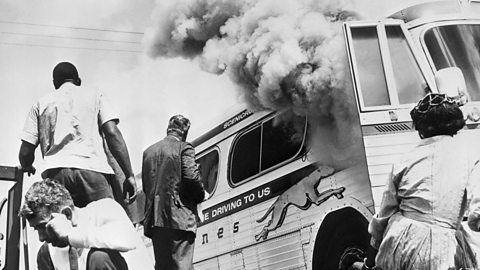Progress in civil rights, 1960 - 1962
After the success of sit-ins, civil rights organisations decided to try another form of direct actionThe use of protests, strikes or even violence as a way of achieving your aims.. They planned to test whether interstate bus travel had really been desegregationRemoval of laws that separate people from different races in public places and day-to-day life..
The Freedom Rides
In 1960, in a court case known as Boynton v Virginia, the US Supreme CourtThe ultimate court of appeal in the USA. It makes the final decision on whether a law is permitted by the US Constitution. had ruled that interstate travel should be desegregated. CORE activistsPeople who actively campaign for a cause. wanted to show that the courtâs rulings were not being followed. They wanted to provoke anger and gain publicity just as the sit-in movement was doing.
A group of 13 activists, seven black and six white, intended to travel 1,500 miles by bus through the southern states to New Orleans. These Freedom RidersCivil rights activists who travelled on public transport between states to show desegregation had not been achieved. were split between two buses. Their tactics were to have at least one interracial pair sitting in adjoining seats and at least one black rider sitting up front, where seats were usually reserved for white customers. It was not long before they met opposition.
The ride to Montgomery, 1961
When the Riders reached Anniston, Alabama, a mob was ready for them. On 14 May 1961, the first bus was attacked. Its passengers were beaten and the bus was firebombed. When the other bus reached Birmingham, Alabama, mob violence continued. The violence was reported worldwide in news bulletins, causing other countries to condemn the USA. Japanese investors, for example, pulled out of a planned factory build in Birmingham.

After the first round of violence, most of the Freedom Riders decided not to continue. However, the Student Nonviolent Coordinating Committee SNCCStudent Nonviolent Coordinating Committee initially promoted non-violent protest. organised replacements and sent them to Birmingham. The federal governmentThe central government in the USA, including the president, Congress and the Supreme Court. asked the state governorA person who is elected to lead a stateâs government in the USA. to protect the Riders, but at Montgomery they were attacked by an angry white crowd, led by Ku Klux KlanA white supremacist organisation that used violence and intimidation to target black, immigrant, Jewish and Catholic people. Its members believe, based on incorrect and unscientific ideas about evolution, that white people are superior and should therefore hold the power in society. (KKK) members. The federal government then intervened, sending in US MarshalsOfficers in the USA who enforce federal laws and respond to crisis situations. and declaring martial lawThe imposition of military government, involving the suspension of ordinary law. to calm the situation.
When the Riders continued their journey to Jackson, they again received police protection. However, when they got to Jackson, they were arrested and the first ride came to an end.
Results of the Freedom Rides
After the first Riders were arrested, a Freedom Riding Coordinating Committee was set up. There were more than 60 Freedom Rides in the summer of 1961, and these continued to attract violence from white people. Yet it was often the Freedom Riders who were arrested, rather than their attackers.
By November 1961, President John F Kennedy intervened. He said that if the southern states did not desegregate interstate travel, he would send in US marshals to do it. Most states enforced the order.
James Meredith and university admission
In January 1961, James Meredith applied to the University of Mississippi. If he had been accepted, he would have been the first black student to attend the university. Even though Meredith met the entry criteria, the university refused to accept him.
In June 1962, the Supreme Court ordered the university to admit Meredith. However, under pressure from the state governor, Mississippi passed a law saying that no one with a criminal record could attend the university. Meredith had once been convicted of false voter registration (a charge commonly brought to intimidate black voters) and so he was excluded.
President Kennedy ordered the university to admit Meredith, and his start date was set as September 1962. The governor of Mississippi publicly declared that he would prevent any black person from attempting to enrol at the university. Protests and violence followed at the university. To defend Meredith, President Kennedy sent 500 US marshals. When the two sides clashed, there was a serious fight and two men died.
After this, the president sent in many more troops and Meredith was able to enrol. During his time at the university, hundreds of US marshals stayed to protect him. As a result, other states began to accept that school segregation had to end and that they could not stop its desegregation.